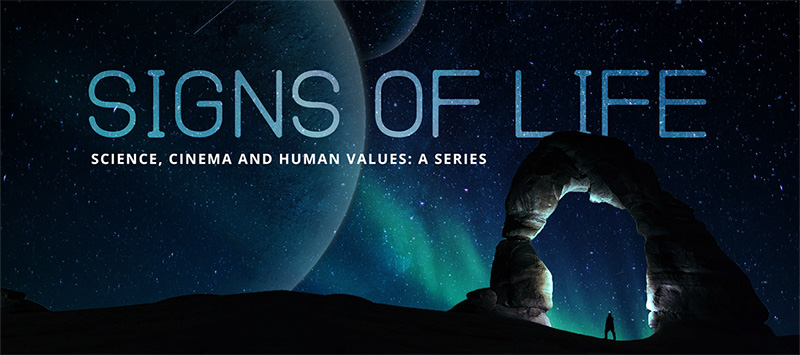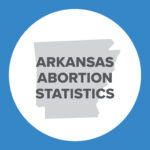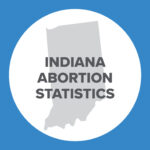Abortion Reporting: West Virginia (2023)
West Virginia’s 2023 abortion statistics by quarter were published throughout 2023 and into March 2024, showing that abortions in the Mountain State have decreased exponentially since 2022.
Statistics and Changes in West Virginia Abortions, 2022-2023

The report does not include information on Planned Parenthood’s West Virginia abortion market share, but Planned Parenthood operates no abortion centers in West Virginia.
Abortion Totals and Trends
In 2023, there were 16 abortions reported in West Virginia, a decrease of 98% from the previous year. There was similarly a drop of 98% in drug-induced abortions between 2022 (403 drug-induced abortions) and 2023 (10 drug-induced abortions). Drug-induced abortions constituted 63% of the total in 2023 (Fig. 1). The Charlotte Lozier Institute (CLI) estimates that West Virginia’s 2023 abortion rate was 0.1 abortions per 1,000 women ages 15 to 44, down 98.1% from 2022 (Fig. 2).1 As of May 2024, 6 states have released 2023 abortion statistics, four of which reported that abortions decreased from the previous year.
State Report Summary
In 2023, 75% of abortions performed in West Virginia were on state residents and 25% were on women from other states. Of the nonresident abortions, one was performed on an Ohio resident and three were performed on Pennsylvania residents. Thirteen percent of the abortions each were performed on girls ages 15 to 19 and women ages 20 to 24. Nineteen percent were performed on women ages 25-29 while 50% were performed on women ages 30-34. One abortion was performed on a woman whose age was 40 or older.
In 2023, two abortions were performed at 8 weeks of gestation or earlier and another two were performed at 11 to 12 weeks of gestation. Six abortions were performed between 16 and 19 weeks of gestation. Five abortions were performed at 20 weeks of gestation or later while one abortion was performed at an unknown gestational age.
In 2023, 63% of West Virginia abortions were drug-induced while 25% were performed using dilation and curettage procedures. Two abortions were performed using dilation and evacuation procedures. Fifty-six percent of West Virginia’s 2023 abortions were paid for via private insurance while 44% were paid for using Medicaid.
Legislative Changes and Ensuing Changes in Abortion Provision
In September 2022, elective abortion was prohibited in West Virginia by HB 302, and the law has remained in effect since its passage. Under this law, abortion is permitted in cases where the mother’s life or physical health is in danger or in cases of rape, incest, ectopic pregnancy, or if the fetus is deemed to be “nonviable.” While a medical indication for separating a mother and her baby is not the same as an induced abortion, which aims to end the life of the unborn child, the state’s law explicitly allows abortion intervention for the aforementioned exceptions. The sexual assault and incest exceptions only apply to pregnancies within the first eight weeks of gestation and within the first 14 weeks for minors. In 2023, all 16 abortions that occurred in the state were performed because of these exceptions. Twelve abortions were performed because the fetus was “non-medically viable.” The conditions listed included ectopic pregnancy, Meckel-Gruber Syndrome, anencephaly, fetal acrania, hydramnios, fetal hydrops, and twin reversed arterial perfusion. There were two abortions performed because the mothers’ lives were at risk. In both cases the woman was diagnosed with chorioamnionitis. There were two abortions performed because of a fetal congenital anomaly, with one case being a lethal bladder obstruction and one case of Trisomy 13.
The 2023 ITOP reports contain sections on monthly abortion occurrence data. A table from the report containing that data, which CLI compares to prior 2022 monthly totals, is reproduced below. One can see that once the prohibition on elective abortion went into effect in September 2022, monthly abortion totals dropped dramatically.
Table 1 – 2022 and 2023 Monthly Abortion Occurrence Totals in West Virginia
| # of ab. occurring in WV in 2023 | # of ab. occurring in WV in 2022 | |
| January | 2 | 98 |
| February | 1 | 126 |
| March | 1 | 157 |
| April | 1 | 85 |
| May | 1 | 116 |
| June | 2 | 109 |
| July | 2 | 32 |
| August | 1 | 79 |
| September | 3 | 23 |
| October | 0 | 3 |
| November | 2 | 2 |
| December | 0 | 1 |
State Ranking
In 2016, CLI analyzed abortion reporting across the 50 states, the District of Columbia, and New York City. West Virginia tied for 21st best. The state has improved its reporting since then, most recently with the quarterly report requirement. To further improve its reporting, West Virginia could collect and report data on complications caused by abortions, as many other states do. This data is increasingly important as the distribution of abortion drugs associated with higher complication rates for women rises.
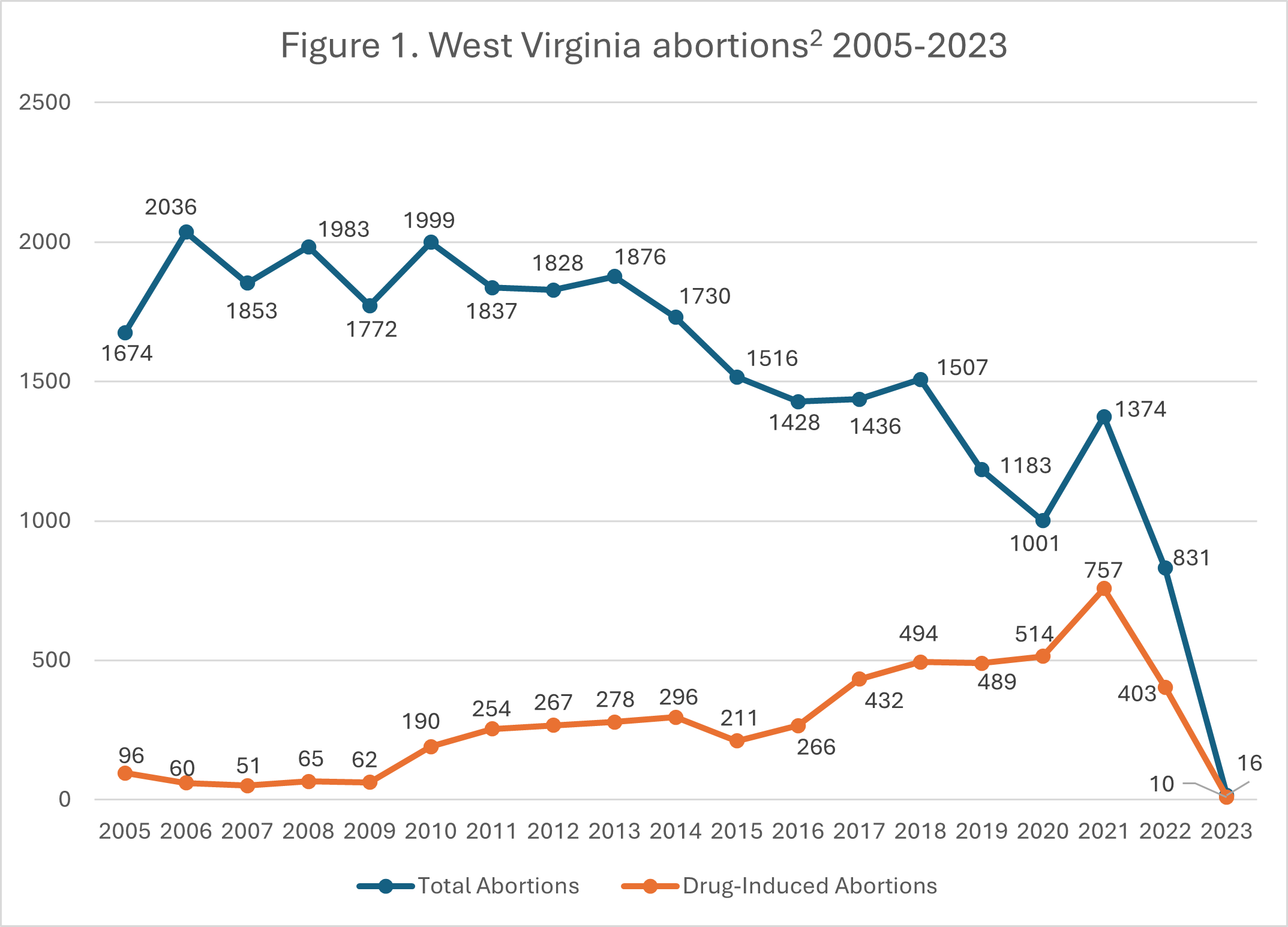
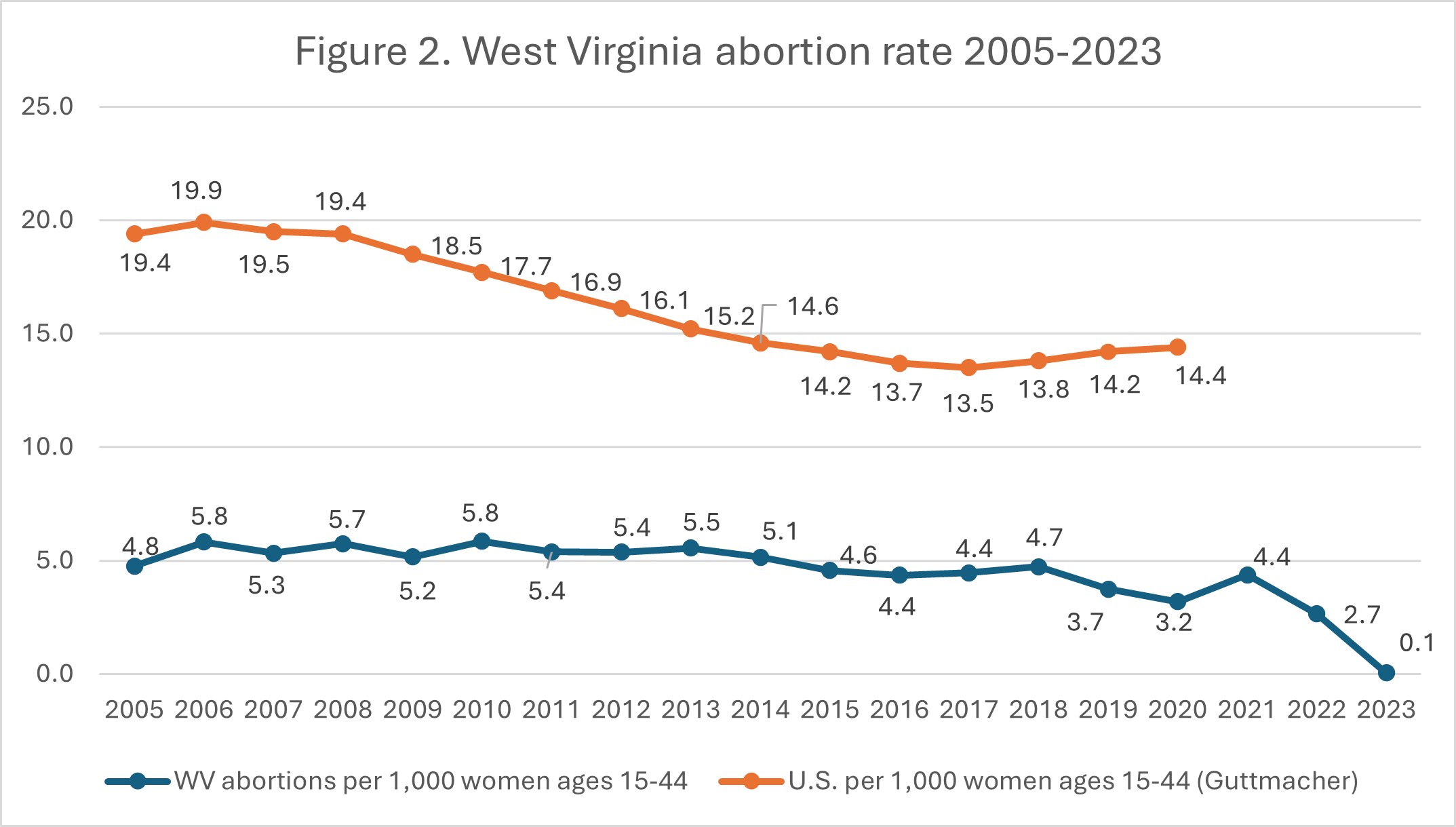
- National rates were calculated by the Guttmacher Institute. West Virginia rates were calculated by CLI using the following formula: (total number of abortions performed in West Virginia ÷ number of resident women ages 15-44 [based on most recent population estimates]) x 1,000. Rates may differ slightly from previous CLI articles due to revised population estimates. Population estimates were obtained from the CDC WONDER database. Estimates for 2005-2009 are intercensal estimates of the July 1 resident population. Estimates for 2010-2019 are Vintage 2020 postcensal estimates of the July 1 resident population. Estimates for 2020-2022 are Vintage 2022 postcensal estimates of the July 1 resident population. Estimates were produced by the U.S. Census Bureau and the National Center for Health Statistics. Rates for 2023 were calculated using the Vintage 2022 postcensal estimates because 2023 population estimates have not yet been released by the CDC.
- Total and drug-induced abortions for 2005-2015 were taken from CDC surveillance reports. Totals for 2016-2020 were taken from West Virginia’s 2020 abortion report.






